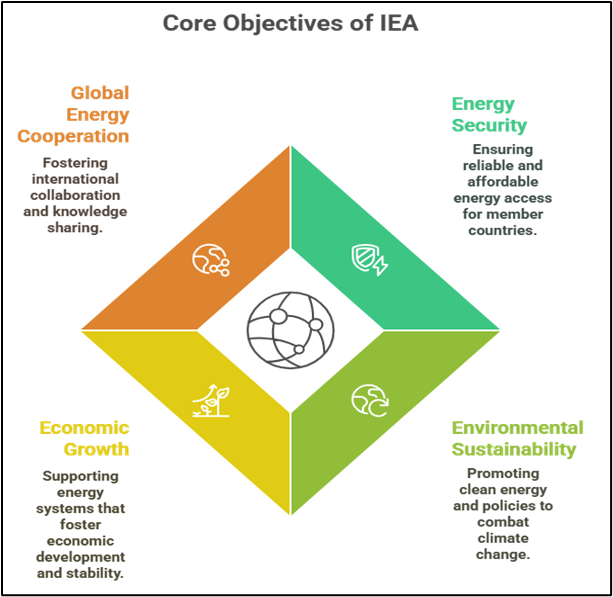- Courses
- GS Full Course 1 Year
- GS Full Course 2 Year
- GS Full Course 3 Year
- GS Full Course Till Selection
- Online Program
- GS Recorded Course
- NCERT (Recorded 500+ Hours)
- Polity Recorded Course
- Geography Recorded Course
- Economy Recorded Course
- AMAC Recorded Course
- Modern India, Post Independence & World History
- Environment Recoded Course
- Governance Recoded Course
- Science & Tech. Recoded Course
- International Relations and Internal Security Recorded Course
- Disaster Management Module Course
- Ethics Recoded Course
- Essay Recoded Course
- Current Affairs Recoded Course
- CSAT
- 5 LAYERED ARJUNA Mentorship
- Public Administration Optional
- ABOUT US
- OUR TOPPERS
- TEST SERIES
- FREE STUDY MATERIAL
- VIDEOS
- CONTACT US
Global Methane Tracker 2025
Global Methane Tracker 2025
12-05-2025
Context:
- According to the International Energy Agency (IEA)’s Global Methane Tracker 2025 Report, the fossil fuel sector continues to release methane at alarming levels, making it a major driver of global warming.
What is Methane?
- Methane is a powerful greenhouse gas. It has caused about 30% of global warming since the Industrial Revolution.
- Its levels in the atmosphere are now 2.5 times higher than they were before industrial times and are increasing faster than any other major greenhouse gas.
- Methane (CH₄)
- Source: Agriculture (especially livestock), landfills, oil and gas extraction, wetlands.
- Warming potential: About 28–36 times more potent than CO₂ over 100 years.
- Lifespan: Around 12 years.
- Global Warming Potential (GWP): 27 to 30 (over 100 years)
- Methane (CH₄)
Greenhouse Gases (GHGs):
- Greenhouse gases trap heat in the Earth’s atmosphere and contribute to global warming and climate change.
- The major Greenhouse Gases:
- Carbon Dioxide (CO₂)
-
- Source: Burning of fossil fuels (coal, oil, natural gas), deforestation, cement production.
- Share in GHG Emissions: Largest contributor (approximately 76% of global GHG emissions).
- Lifespan in atmosphere: Hundreds of years.
- Global Warming Potential (GWP): 1 (baseline)
- Nitrous Oxide (N₂O)
- Source: Agricultural activities (fertilizers), fossil fuel combustion, industrial processes.
- Warming potential: About 273 times that of CO2 for a 100-year.
- Lifespan: Approximately 114 years.
- Fluorinated Gases
- Name of Gases: Chlorofluorocarbons (CFCs), Hydrofluorocarbons (HFCs), Hydrochlorofluorocarbons (HCFCs), Perfluorocarbons (PFCs), Sulfur Hexafluoride (SF6) , and Nitrogen Trifluoride (NF3)
- Source: Industrial processes, refrigerants, electronics manufacturing.
- Warming potential: Thousands of times more than CO₂.
- Lifespan: Varies: Decades to thousands of years.
- Water Vapor (H₂O)
- Act as a potent greenhouse gas.
- Increases with temperature (positive feedback loop).
- Plays a major role in the natural greenhouse effect.
-
- Global Warming Potential (GWP):
- It talks about how much heat a greenhouse gas traps in the atmosphere compared to carbon dioxide (CO₂).
- It measures how strongly a gas is able to cause global warming over a certain time, usually 100 years.
- For example, if a gas has a GWP of 25, it means 1 ton of that gas warms the Earth 25 times more than 1 ton of CO₂ over the same time.
- Main Sources of Methane:
- Agriculture: Methane is emitted from flooded paddy fields, where low oxygen levels promote methane production by methane producing bacteria.
- Energy Sector: The energy sector is one of the largest sources of methane (CH₄) emissions, mainly due to the extraction, processing, and transport of fossil fuels.
- Waste: Methane (CH₄) is a major greenhouse gas released during the decomposition of organic waste in the absence of oxygen.
- The waste sector particularly solid waste and waste water contributes significantly to global methane emissions.
- The Main Sources from Energy Sector:
- Oil
- Natural gas
- Coal
- Bioenergy (like wood, dung, or crop waste used as fuel)

- The top countries responsible for the highest methane emissions from fossil fuels are China, the United States, Russia, Iran, Turkmenistan, India, Venezuela, and Indonesia.
- A new round of Nationally Determined Contributions (NDCs) for 2035 is expected to be revealed soon, but so far only Brazil, Canada, United Arab Emirates, and the United Kingdom have included methane reduction in its NDCs.
Nationally Determined Contribution (NDCs):
- Definition:
- NDCs are climate action plans that each country submits under the Paris Agreement (2015).
- They outline how a country will reduce greenhouse gas (GHG) emissions and adapt to climate change.
- NDCs are submitted every five years to the United Nations Framework Convention on Climate Change (UNFCCC) secretariat.
- Key Features:
- Country-Specific: Each country decides its own goals based on national circumstances.
- Legally Binding Framework: The targets mentioned in the NDCs are not legally binding.
- Reviewed Every 5 Years: Countries must update and strengthen their targets periodically.
- Covers Mitigation and Adaptation: Includes plans to reduce emissions and manage climate impacts.
- Goal:
- To help achieve the global goal of limiting temperature rise to well below 2°C, preferably 1.5°C, compared to pre-industrial levels.
Challenges:
- Many countries underestimate or underreport their methane emissions.
- IEA estimates are 80% higher than what countries report to the United Nations.
- Only a few countries have solid plans or measurable targets.
- The Global Methane Pledge (GMP) was launched in 2021, but many big emitters like India, China, Russia, and Iran have not joined.
- The coal sector is mostly not involved in any global methane reduction pledges.
- Only 30 countries mentioned methane in their current NDCs, and only nine gave specific reduction targets.
Way Forward
- Strengthen Reporting and Monitoring Mechanisms: Encourage the adoption of satellite-based and independent verification systems to improve transparency and accuracy in methane reporting.
- Expand Global Participation: Intensify diplomatic engagement to bring major emitters like India, China, Russia, and Iran into the Global Methane Pledge (GMP).
- Integrate Methane Targets in National Climate Plans: Urge all countries to explicitly include methane targets in their Nationally Determined Contributions (NDCs).
- Include the Coal Sector in Mitigation Strategies: Launch targeted initiatives to address methane leaks in coal mines, especially in countries with high coal dependency.
- Incentivize Technology Adoption: Provide financial incentives and public-private partnerships to deploy methane abatement technologies in key sectors like agriculture, oil and gas, and waste.
Conclusion:
Methane is a major cause of climate change, but reducing it is one of the easiest and cheapest ways to slow global warming. The world has the technology, and fossil fuel companies have the money to fix the problem. What is needed now is stronger action, better policies, and more countries joining global efforts.
|
International Energy Agency (IEA):
|
|
Also Read |
|
| FREE NIOS Books | |





